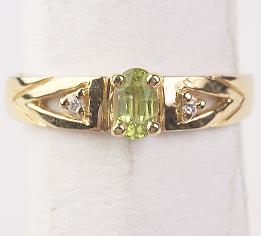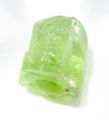Peridot
From Giftypedia
Peridot, sometimes referred to as 'the volcanic gemstone,' is the gemstone of the month of August. Formed during volcanic activity, it's color ranges from bright yellow-green to dark lime-green, offering more choices in the green color family. Widely popular today, the fashion industry has promoted the peridot gemstone to complement summer wardrobes due to its green radiance - the color of nature.
Peridot gemstones are featured in earrings, bracelets, pendants and rings in a variety of styles and price ranges. Peridot is used both as faceted gems and as tumbled gems. Tumbled gems can be set in Baroque jewelry, drilled and strung as beads and used in mosaics. The popularity of peridot is increasing yearly with new finds in Pakistan.
One of the few, peridot gemstones are only found in one color, green, though the depth of the color varies. The green color of the peridot, with a slight yellow-gold tint, is caused by fine traces of iron. The more iron, the more intense the color.
Mystical Powers
The stone is believed to bring success, peace, and good luck to the wearer. Other powers associated with the peridot include health, protection, and sleep. Attracting love, calming anger, soothing nerves and dispelling negative emotions are also attributed to the powers of the gemstone. [1]
History
An ancient gemstone, the peridot has been traced back thousands of years. It has been discovered in Egyptian jewelry from the 2nd millennium B.C. Reportedly, the stones from this period came from a volcanic island in the Red Sea. Peridot is even mentioned in the Bible under the name of "chrysolite" or the Hebrew name of "pitdah."
According to legend, the peridot was one of the favorite gemstones of Cleopatra. Historians believe that some of the emeralds worn by her were actually peridot. Because the radiant green color does not change in any light, it was nicknamed 'emerald of the evening' by the Romans.
| FACTS |
|---|
Tips
Care
|
References
Related Items
Cite error: <ref> tags exist, but no <references/> tag was found






 Printer Friendly
Printer Friendly
